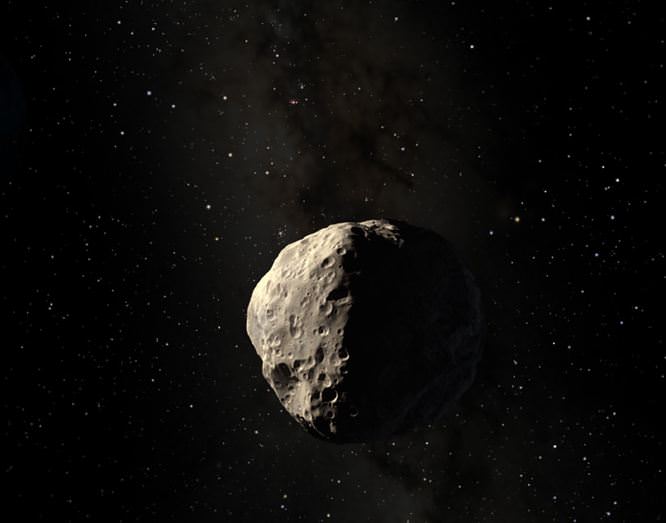An artist’s rendering of the asteroid Apophis. Credit: ESA
What would be a way to deflect asteroid Apophis if it gets a little too close for comfort in 2029 or 2036? Pew-pew it with 5 tons of white paintballs. Not only would the multiple mini impacts bump the asteroid off course, but the white paint would cover the surface and reflect more sunlight, and over time, the bouncing of photons off its surface could create enough of a force to push the asteroid off its course.
That’s the idea of the winning entry in this year’s Move an Asteroid Technical Paper Competition, sponsored by the United Nations’ Space Generation Advisory Council. Sung Wook Paek, a graduate student in MIT’s Department of Aeronautics and Astronautics, says if timed just right, pellets full of paint powder, launched in two rounds from a spacecraft at relatively close distance, would cover the front and back of an asteroid, more than doubling its reflectivity, or albedo. The initial force from the pellets would bump an asteroid off course; over time, the sun’s photons would deflect the asteroid even more.
This video portrays how the paintball technique would work:
There have been lots of ideas put forth for possible asteroid deflection, such as using a gravity tractor to pull it off course, hitting it with a projectile or spacecraft to move it, or attaching a solar sail to change its course, to name a few.
Paek said his paintball strategy builds on a solution submitted by last year’s competition winner, who proposed deflecting an asteroid with a cloud of solid pellets. Paek came up with a similar proposal, adding paint to the pellets to take advantage of solar radiation pressure — the force exerted on objects by the sun’s photons.
In his proposal, Paek used the asteroid Apophis as a theoretical test case. This 27-gigaton rock may come close to Earth in 2029, and then again in 2036. Paek determined that five tons of paint would be required to cover the massive asteroid, which has a diameter of 450 meters (1,480 feet). He used the asteroid’s period of rotation to determine the timing of pellets, launching a first round to cover the front of the asteroid, and firing a second round once the asteroid’s backside is exposed. As the pellets hit the asteroid’s surface, they would burst apart, splattering the space rock with a fine, five-micrometer-layer of paint.
But this is not a quick-solution method, as Paek estimates that it would take up to 20 years for the cumulative effect of solar radiation pressure to successfully push the asteroid off its Earthbound trajectory. So if astronomers determine Apophis is a threat in 2029, we’re already too late. Additionally, the paintball method is not an option if estimates change for Asteroid 2012 DA14, which is predicted to pass very close to Earth on February 15, 2013, about 35,000 kilometers (21,000 miles) away.
Plus, using traditional paintballs, or traditional rockets for launching them, may not be ideal. Paek says the violent takeoff may rupture the payload. Instead, he envisions paintballs may be made in space, in ports such as the International Space Station, where a spacecraft could then pick up a couple of rounds of pellets to deliver to the asteroid.
But other substances could also be used instead of paint, such as aerosols that, when fired at an asteroid, “impart air drag on the incoming asteroid to slow it down,” Paek says. “Or you could just paint the asteroid so you can track it more easily with telescopes on Earth. So there are other uses for this method.”
Scientists have said the key to deflecting a dangerous asteroid is to find them early so that a plan can be developed. William Ailor, an asteroid specialist at Aerospace Corporation in California said that the potential for an asteroid collision is a long-term challenge for scientists and engineers.
“These types of analyses are really timely because this is a problem we’ll have basically forever,” Ailor says. “It’s nice that we’re getting young people thinking about it in detail, and I really applaud that.”
Source: MIT

